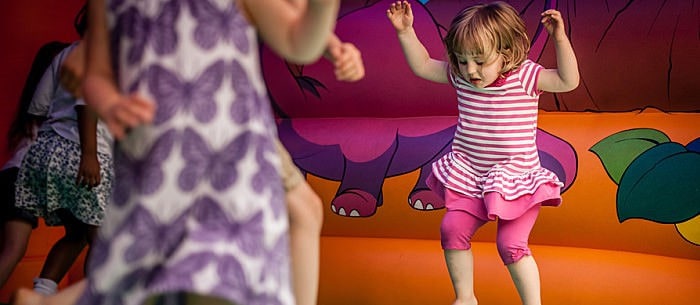Your 3-year-old comes barreling toward you, stops suddenly, twirls and gives a cute little shimmy as she hops away. What happened to her wobbly toddler legs? Your preschooler is growing up and getting more agile all the time. According to the American Academy of Pediatrics (AAP), 3-year-olds show increasing complexity in coordination and movement. While your little leaper still isn’t done developing, her growing physical prowess makes her feel and act more independent. But she still needs mom or dad – or a caregiver! – close at hand to make sure she’s charging ahead safely.
And read
our guide to developmental milestones for kids
.
What Types of Physical Skills Are Developing?
At 3 years old, your baby is fine-tuning her gross motor skills. Gross, or large, motor skills include muscle coordination and balance, allowing your child to move her entire body. The milestones at this age include standing on one foot for up to five seconds, kicking, throwing, catching and moving forward and backward. Your child is also starting to walk up and down the stairs without asking for your support.
Now that she’s running, climbing and hopping, you need to keep both eyes firmly focused on your little one. Her reasoning skills haven’t quite caught up with her physical abilities: Just because she can climb up the bookcase doesn’t mean she should. Since you’re well aware of the dangers around your house, your vigilance is essential.
During this stage of development, it’s common for kids to use their bodies to make up for the words they don’t have, notes the AAP. When she’s angry, she might shake her fist, or if she’s overjoyed, she might jump up and down.
Your 3-year-old is also refining her fine, or small, motor skills at this age. Fine motor skills allow your child to use her hands and fingers in coordination. Maybe she just peeled a banana on her own! Everyday feats such as peeling fruit are really pint-sized practice for physical development, notes Katie Joiner, a mother, preschool teacher and creator of the parenting blog Happily Ever Mom. Look for other milestones such as drawing basic shapes like squares and possibly writing a few capital letters.
How Can You Boost Motor Development?
Joiner suggests letting your preschooler help you out in the kitchen by peeling oranges, picking grapes off the stalk or even pulling the seeds out of a pomegranate. These activities pull double duty, with Joiner noting, “Not only is it great for their fine motor development, but it encourages healthy eating, too!” Pediatrician Orlena Kerek, creator of the blog Snotty Noses, notes that the key to building motor skills is making it fun, from art to the everyday. “Play-Doh is great for fine motor skills — you can practice using a spoon or fork and making different shapes,” Kerek says.
Other activities that can boost fine motor skills include supervised scissor practice. Dyan Robson, blogger behind And Next Comes L and co-author of “99 Fine Motor Ideas for Ages 1 to 5,” notes, “You’d be surprised at how many kids have never used a pair of child scissors before entering school.” Robson suggests, “Don’t be afraid to introduce child scissors. Provide different materials for them to practice with — ribbons, straws, Play-Doh, paper and flowers.” Your child can also use temperas with rollers or brushes or even finger-paint with soft modeling clay!
To practice gross motor skills, get sporty. Roll a ball back and forth, bounce it or kick it across the yard. If you’re stuck indoors, put on her favorite song and let her dance to the music or march around the house in a pretend parade. Leap over small sticks in the yard or practice taking big, huge steps. Have fun showing her all the ways her body works and help boost her coordination and motor development at the same time.
For more, check out this Overview of Milestones for 3 Year Olds.
Erica Loop is a freelance parenting writer, educator and mom with an M.S. in child development. When she’s not teaching, she’s busy creating activities for her blog Mini Monets and Mommies.
* This article is for general informational purposes only. It is not intended nor implied to be providing medical advice and is not a substitute for such advice. The reader should always consult a health care provider concerning any medical condition or treatment plan. Neither Care.com nor the author assumes any responsibility or liability with respect to use of any information contained herein.






